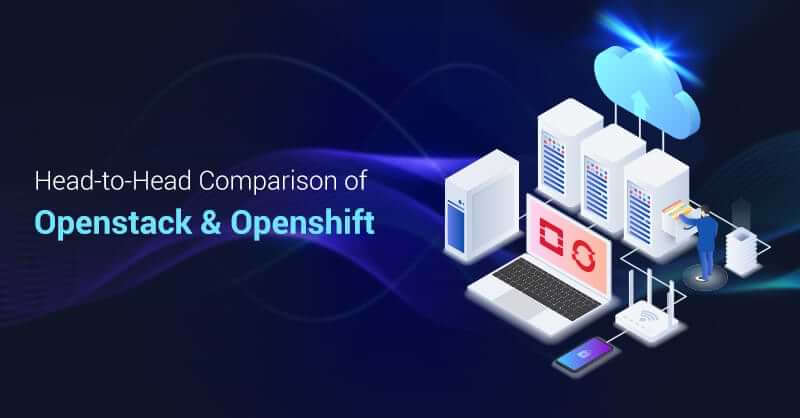Head-to-Head Comparison of Openstack & Openshift

Written by Afsa Ashraf
Content Writer
April 25, 2022
What is the Difference between OpenShift and OpenStack Platform?
In the world of cloud computing and container orchestration, OpenStack and OpenShift are two prominent open-source platforms that serve distinct purposes. OpenStack is primarily used for managing and provisioning infrastructure resources, while OpenShift is designed for container orchestration and application deployment. In this blog post, we will delve into a comprehensive head-to-head comparison of OpenStack and OpenShift to help you understand their key differences and use cases.
OpenShift and OpenStack are used to build scalable cloud platforms. The systems cover the entire range – from provisioning virtualized hardware to developing and operating containerized applications. OpenShift and OpenStack are popular with large, global organizations to implement hybrid cloud strategies.
Historically, OpenStack has been around longer than OpenShift. The evolution of the two projects is representative of the transition from virtual machines to application containers. Container virtualization has become the dominant virtualization technology over the past decade.
Read our blog to learn the difference between OpenShift vs Kubernetes when it comes to container orchestration.
What is OpenStack?
OpenStack is a free, open-source cloud computing platform for public and private cloud management. It’s known as Infrastructure as a Service (IaaS), offering infrastructure for deploying applications and operating systems. Initially exclusive to Linux, OpenStack now supports both Linux and Windows.
OpenStack is cost-effective, ideal for commodity hardware, and has essential components: compute, network, and storage modules. These modules integrate files to enable cloud functionality. It provides a web-based dashboard for user-friendly interaction but offers a stateless GUI model for creating front-ends. For maximum flexibility and robustness, the command line is the preferred method of interaction and management.
Benefits of OpenStack
- IT resources can be deployed more quickly.
- Faster and more efficient access to IT resources.
- Improves resource utilization and scalability.
- With no lock-in period, this is a very cost-effective option.
- Read/write highly scalable access.
- User accounts, containers, and object copies have high availability.
- Can scale both vertically and horizontally.
What is OpenShift?
OpenShift, powered by Red Hat, simplifies Kubernetes-based application deployment. It offers various options and Red Hat support. OpenShift allows running containerized applications on Kubernetes without the need to master Kubernetes intricacies. It provides CLI and web interface dashboards for developers to focus on code, while the operations team handles cluster management and monitoring. You can deploy Docker containers in OpenShift without the need to customize every Kubernetes cluster component. It’s a fully managed platform-as-a-service for container deployment.
New to OpenShift? Watch our video to learn how to migrate your application to Red Hat OpenShift.
Benefits of OpenShift
- Builds and deployments that are more agile and confident.
- Simple to use on-premises (bare metal) or with any cloud provider (virtual hardware).
- Simple integration with a variety of DevOps tools.
- Implements and enforces policies on Red Hat using a unified console.
- Easily monitors the cluster with built-in tools such as Prometheus and Grafana.
- Ensures that builds are secure throughout the application’s lifecycle.
Download our whitepaper to get a quick guide on how to deploy applications in OpenShift.
Quick Comparison Guide
| OpenStack | OpenShift | |
|---|---|---|
| Purpose and Use Cases | OpenStack is an IaaS platform for managing virtualized resources, popular among cloud providers and enterprises for building flexible cloud environments | OpenShift, a PaaS solution, simplifies containerized application deployment and management using Docker and Kubernetes, catering to developers and DevOps teams. |
| Architecture | OpenStack offers a modular architecture with components like Nova, Cinder, Neutron, and Swift, providing high control but requiring in-depth knowledge | OpenShift is built on Kubernetes, simplifying cluster management with components like the Master control plane, Nodes, and an Application Layer, allowing developers to focus on coding. |
| Ease of Deployment | Deploying OpenStack can be complex, especially for newcomers, requiring extensive configuration and tuning. However, tools like the Red Hat OpenStack Platform can simplify installation and management. | OpenShift provides a simpler deployment experience. Users can opt for OpenShift Container Platform (on-premises) or OpenShift Dedicated (managed service) with an installer that streamlines setting up Kubernetes clusters and containerized apps. |
| Scaling and High Availability | OpenStack supports horizontal scaling but demands careful planning and redundancy mechanisms for high availability, involving load balancing, failover, and distributed storage. | OpenShift, built on Kubernetes, naturally supports scaling and high availability. Kubernetes features like auto-scaling and self-healing ensure smooth operation during failures, simplifying application scaling based on demand. |
| Application Development and CI/CD | OpenStack lacks native tools for application development and CI/CD, requiring users to integrate third-party tools. | In contrast, OpenShift offers native application development and CI/CD support with features like Source-to-Image (S2I) and Jenkins integration, making it a developer-friendly platform for application building, testing, and deployment. |
| Community and Ecosystem | OpenStack boasts a large and active community with numerous plugins and third-party integrations. It also offers various commercial support options. | OpenShift is supported by Red Hat, offering commercial services with an active open-source community. Though its ecosystem is less extensive than OpenStack’s, it’s well-suited for enterprise use. |
| Scalability and Resource Management | OpenStack achieves scalability by adding hardware resources, but efficient management demands planning and expertise. It offers resource management tools like Nova, Cinder, and Neutron, necessitating manual monitoring and adjustments. | OpenShift leverages Kubernetes’ robust resource management, automating scaling and allocation based on CPU and memory usage. This dynamic resource management simplifies scaling, optimizing resource utilization for varying workloads. |
| Multi-Tenancy and Isolation | OpenStack offers multi-tenancy features for sharing infrastructure with isolation. Users create virtual networks, allocate resources, and apply RBAC policies for security. Administrators can customize multi-tenancy configurations. | OpenShift enhances Kubernetes’ multi-tenancy. Kubernetes namespaces provide basic isolation, but OpenShift adds security features like network policies, RBAC, and project-based quotas. This ensures secure coexistence of teams or projects on the same cluster. |
| Application Deployment and Management | OpenStack efficiently provisions infrastructure resources but lacks native application deployment and management tools. Users rely on external tools, resulting in longer deployments and complex workflows. | OpenShift excels in application deployment and management, offering tools like Source-to-Image for streamlined containerization. It simplifies application deployment, scaling, and management using Kubernetes manifests and Helm charts. Integrated CI/CD pipelines with Jenkins or Tekton automate the application lifecycle, boosting developer productivity. |
| Ecosystem and Integrations | OpenStack has a vast ecosystem, enabling users to customize cloud environments but requiring expertise to manage its diversity and integrations. | OpenShift’s ecosystem, while not as extensive as OpenStack’s, aligns with Kubernetes, simplifying integration with native Kubernetes tools and services. Users can leverage Helm charts, operators, and Kubernetes-native monitoring/logging solutions for extending and enhancing containerized applications. |
| Commercial Support | For OpenStack, vendors like Red Hat, Canonical, and Mirantis offer commercial support and distributions, enhancing deployment and management with added features. | OpenShift, backed by Red Hat, a top enterprise Linux provider, provides commercial support, including managed services like Red Hat OpenShift Dedicated and on-premises solutions like Red Hat OpenShift Container Platform, ensuring reliability and robust support for enterprises. |
Conclusion
In summary, OpenStack and OpenShift serve different purposes in cloud computing and container orchestration. OpenStack is an IaaS platform that provides infrastructure management and virtualization capabilities, while OpenShift is a PaaS solution designed for container orchestration and application development.
The choice between OpenStack and OpenShift depends on your organization’s needs and priorities. OpenStack may be the better choice if you require a highly customizable infrastructure platform for building private or public clouds. On the other hand, if your focus is on containerized application development and rapid deployment, OpenShift offers a more streamlined and developer-friendly experience.
Royal Cyber can assist you with OpenShift Consulting Services to help you evaluate, deploy, and integrate OpenShift into your environment. We are a professional services firm that provides tailored solutions per the client’s requirements. If you would like to know more and learn more about the same or are looking for a partner who can get you the most out of the Platform, reach out to us at [email protected] or visit www.royalcyber.com.



